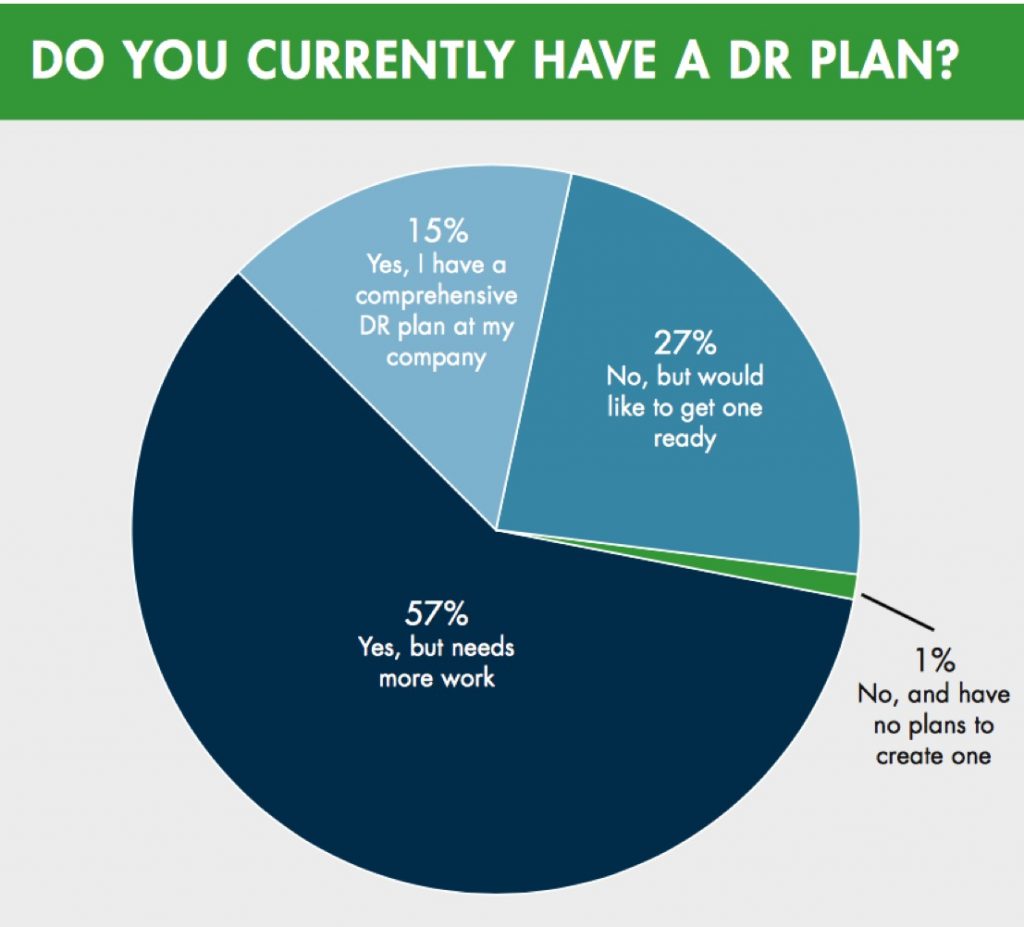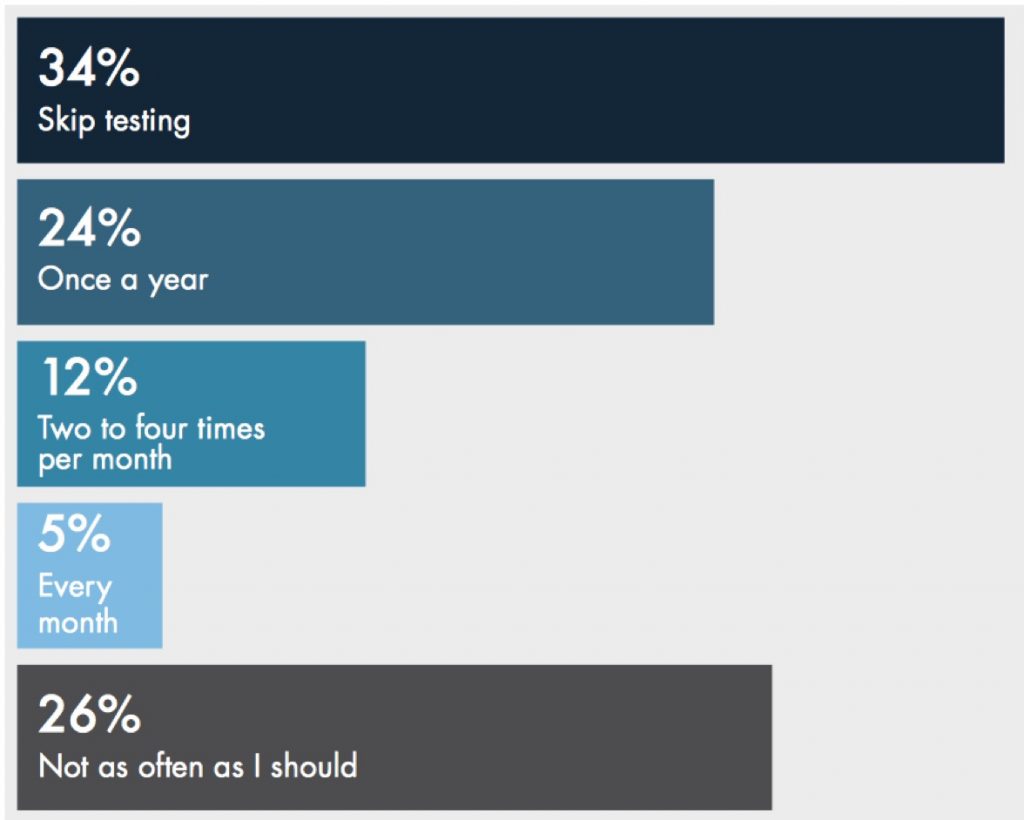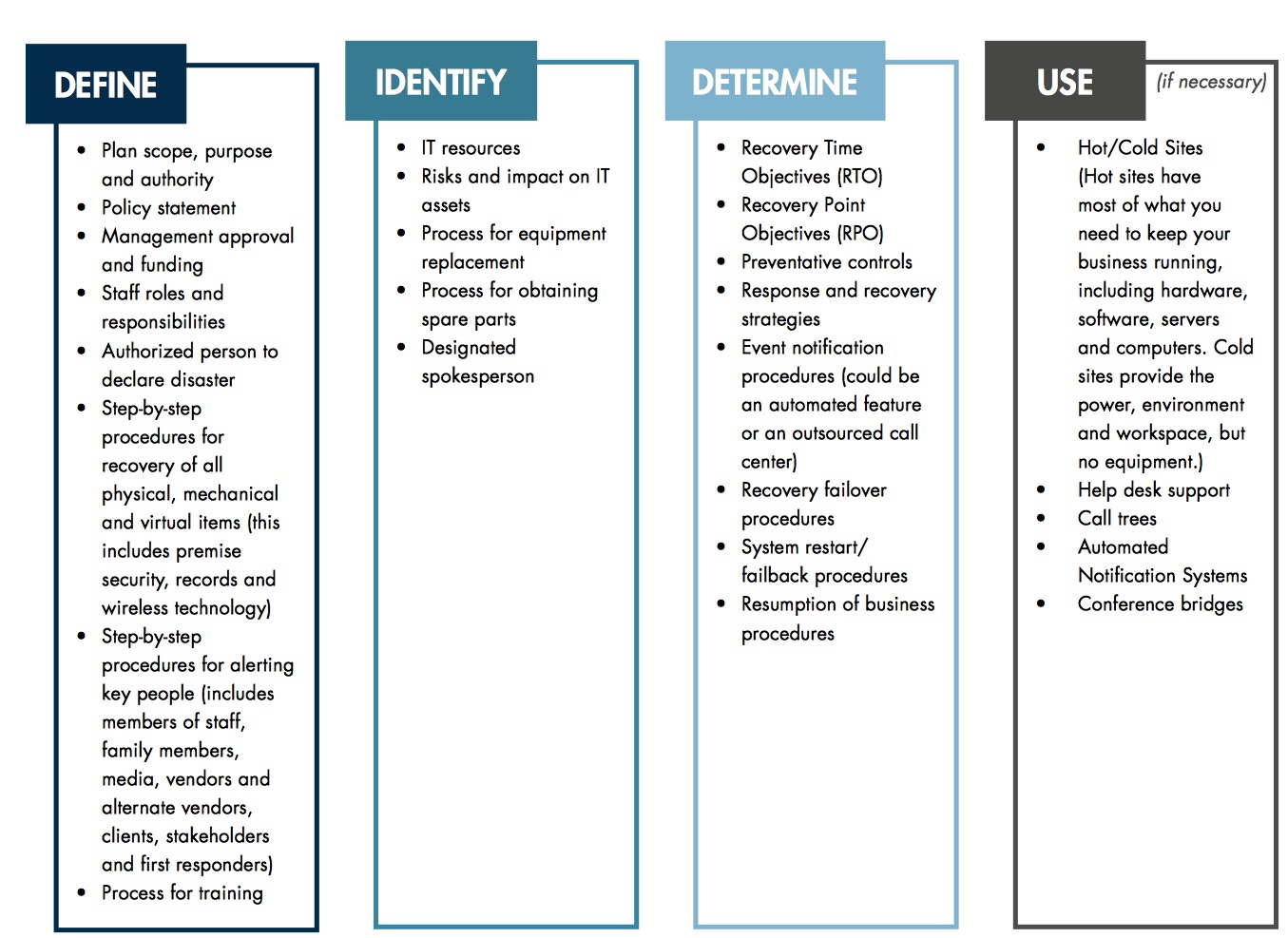Best Practices in DR Planning and Testing – Axcient
Key elements necessary for plan to run efficient
This is a Press Release edited by StorageNewsletter.com on December 1, 2017 at 2:36 pmThis is a paper written by Axcient Holdings LLC, in recovery-as-a-service.
Best Practices in DR Planning and Testing
According to FEMA, over 40% of small businesses do not re-open after a disaster. While every outage is not the result of a disaster that closes businesses, every outage does cost businesses money.
DR plans are widely accepted as a way to ensure all critical data, IT systems and networks can be recovered in the event of an outage. These plans also ensure that business objectives can be achieved during the disruption. In short, it is a plan that keeps a business operational.
In a recent DR survey, we asked business owners if they currently had a DR plan in place. While only 1% felt secure without one, the overwhelming majority didn’t. More than 57% of those surveyed said they currently have a plan that needed a little work; 27% said they don’t have a plan, but would like to develop one; and the remaining 15% have a plan that they felt was good to go.
You may think of these plans as a documented strategy to save your business in the event of a major disaster like a flood or fire, and you wouldn’t be alone. But the reality is that a DR plan is created to protect your infrastructure against any event that could cause disruption, including technical glitches, system failures, power outages and even cyber attacks or data theft. These disruptions cost companies thousands (and in some cases hundreds of thousands) of dollars in damage and an even bigger loss at the end: damage to the company’s brand.

Devising your plan
There are a few key elements necessary for your plan to run efficiently:
- Management Support: Without the support of management, getting your plan operational will be challenging.
- Approved Funding: Upfront approval on funding speeds bringing your plan to life by eliminating budgetary surprises.
- Structured Plan Framework: Buy-in on a well structured plan ensures everyone is on the same page and proper expectations are in place.
- Access to Qualified Staff: Don’t assume that everyone on your IT team is quali ed to put together or execute this plan. This may require additional training or bringing in expert consultants.
- Access to Relevant Information: You’ll need to conduct a little research or a few interviews to gather the information you need.
- Documentation and Testing: Your plan has to be documented and tested regularly to ensure smooth execution in the event of an outage.
All of these elements combine to form the goal of the DR plan, which is to build a plan and associated documentation based on a structured framework that is consistent with good practices and standards. These good practices and standards ensure that you’re not only following the guidelines of what’s best for your business and industry, but that you are also compliant with any regulations that surround recovery and planning in your industry and country.
Common standards used in the DR industry include:
• Standards: NFPA 1600:2010; ISO 27031:2011; ISO 22301:2012; NIST 800-34
• Regulations: FINRA 4370
• Good Practice: BCI Good Practice Guidelines, FFIEC Handbook
• Corporate DR Policies: Existing corporate policies that should apply to your DR plan
Gathering the above information will take a little time, but it’s worth it to keep your business going through any situation. When gathering this information, it’s important to also identify anything that could cause a glitch in your plan, the objectives you have for your system, network and IT asset recovery and anything your company can do to mitigate your risks. In the next section we will explore the components that make up your plan.
Sample Policies and Standards
For a comprehensive list of existing legislation and regulations worldwide related to DR and BC, refer to the BC Institute publication BCM Legislations, Regulations Standards and Good Practices.
The National Commission on Terrorist Attacks Upon the United States (the 9/11 Commission), recognized NFPA 1600 as the National Preparedness Standard. Created by the National Fire Protection Association, the NFPA 1600 Standard on Disaster/Emergency Management and BC Programs contains provisions related to the development, implementation, assessment and maintenance of programs for prevention, mitigation, preparedness, response, continuity, and recovery.
The ISO/IEC 27031:2011 describes the concepts and principles of information and communication technology (ICT) readiness for BC, and provides a framework of methods and processes to identify and specify all aspects (such as performance criteria, design, and implementation) for improving an organization’s ICT readiness to ensure BC. The ISO 22301:2012 specifies requirements to plan, establish, implement, operate, monitor, review, maintain and continually improve a documented management system to protect against, reduce the likelihood of occurrence, prepare for, respond to, and recover from disruptive incidents when they arise.
NIST Special Publication 800-34, Contingency Planning Guide for Information Technology Systems provides instructions, recommendations, and considerations for government IT contingency planning.
Rule 4370 of the Financial Industry Regulatory Authority requires firms to create and maintain BC plans (BCPs) appropriate to the scale and scope of their businesses, and to provide FINRA with emergency contact information.
The BC Institute Good Practice Guidelines (GPG) are the independent body of knowledge for good BC practice worldwide.
Gathering the above information will take a little time, but it’s worth it to keep your business going through any situation. When gathering this information, it’s important to also identify anything that could cause a glitch in your plan, the objectives you have for your system, network and IT asset recovery and anything your company can do to mitigate your risks. In the next section we will explore the components that make up your plan.
Plan components
The previous information is there to help you structure your plan, but these components are what you need to run it. For a DR plan to actually work, there are certain elements that have to be included. These are all important to the plan’s ease of execution and effectiveness and they begin with your company’s own DR policy. Since both management and non-management staff are involved in DR, everyone should be aware of these policies. A meeting or the distribution of the policy will be necessary as soon as the key members of the plan are identified.
Your DR plan should include the IT DR plan, the results of previous efforts for testing the plan, and supporting documents.
The supporting documents for your DR plan are what stand between a successful recovery and a failed one. These documents include processes for backup, information about off-site storage and processes, vendor and maintenance contracts, diagrams, and training plans.
Next, everything should be compiled into a document. All aspects of your plan (including the above gathered information) should be made available to all DR personnel. Your plan should have a TOC (Table of Contents) and outline that lists each step of the plan in order of importance. (Emergency Response Actions should always come before anything else).
Lastly, include a Business Impact Analysis Report and Risk Assessment Report – this is vital. The RA (Risk Assessment) will outline events that could disrupt your business and the BIA (Business Impact Analysis) will illustrate how these disruptions will impact it.
Things to avoid when creating the DR plan
Although gathering the above information is a lengthy process, avoid skipping any of the steps or required sections. Some businesses make the mistake of utilizing generic DR plans or the plans of other businesses in their industry. This may seem like a time-saver at first, but you’ll see during testing that it could prove disastrous. The other business (or the business that the generic plan is modeled off of) could have more assets or finance than you or have fewer risks than you. So, if that plan only covered natural disasters and your business is the victim of data theft – it’s pretty much useless. This makes research – and more importantly a BIA and RA – a must.
Other pitfalls you’ll want to avoid are:
- Not defining a clear budget from the start
- Creating the plan without management’s backing
- Summarizing procedures in the plan
- Assuming that all systems will be backed-up and running immediately
- Skipping testing and reviews
- Keeping all copies of the DR plan on-site
- Not training DR personnel
- Assuming all listed personnel will be available (including IT staff)
The last item is possibly the most important in this section. As your business grows or expands into other areas, your needs, risks, vendors and key personnel may change. This requires you to manually update the plan and recalculate any figures contained within it. Once you do, the new plan should be discussed and another exercise should take place.
Technology options for DR
For most businesses, recovery of data is a critical element of getting backup and running. This makes the DR technology used, and how it is employed, a critical component of the plan. What kind of technology you use depends on your risks, how much data you have to store, the number of people who need access to that data, and the sensitivity of the data.
When we asked business owners what kind of technology they used for DR, the numbers were surprising. More than 69% said they still use local backup to a disk or tape. While local backup might seem like an attractive option at rst, it leaves businesses susceptible to interruption in a variety of scenarios such as power outage, virus attack, or server crash. All three could have serious business implications.
Due to budgetary constraints, some companies build their own DR architecture, assembling different products or building some infrastructure in-house. We have seen, for example, companies using local backup products in combination with automated scripts developed by their engineers to off-site data to a public cloud storage like Amazon. Other companies mix different flavors of server replication to accommodate for their heterogeneous environment.
While interesting at first, the ‘do- it-yourself’ approach to DR leads to a number of issues. As explored by Forrester Research in its report on the risks related to DIY DR, companies report a number of challenges when it comes to their in- house DR infrastructures, namely:
• Lack of focus on DR relative to other IT projects
• Not enough DR testing
• Lack of funding to keep DR infrastructure up-to-date
• Lack of skills in-house
• Not confident in ability to respond to a real disaster
These results clearly show that bringing DR in-house is not the best choice for most companies. When looking at the different options available, businesses that have taken into consideration the TCO seem to have gotten a better bargain.
While an expanded discussion of TCO is outside the scope of this document, keep in mind that the effectiveness of a DR plan is also tied to the effectiveness of the underlying technology being used to recover from a disaster.
TCO
Total cost for owning a DR solution takes into consideration factors such as:
- Capital Expenditures: Cost of purchasing software, hardware, and implementing the solution
- Operational Expenses: Cost for maintaining the solution, including time spent reviewing backup logs, ensuring successful completion of backup jobs, troubleshooting error messages, testing restores and running full DR tests
- Downtime: The time that it takes to bring les, applications, full servers and a full site back into production after an outage and related costs associated for loss of productivity and revenue
Considerations for DR testing
Businesses responded with surprising answers when asked, How often do you test your DR plan and/or the ability to recover from a disaster?

How often you should test is determined by your risks and assets. Those who are at a greater risk like to test more frequently (say, every week), those who are at a moderate risk may test quarterly, and those who are at a very low risk may only test once a year. However, no matter what category your business is in, you should always test your DR plan.
Tips for testing
Here are a few tips to follow:
- Make sure the test is set for a date that isn’t critical for your business and a date where all participants or alternates are present. You’ll also need to notify your IT staff at least two weeks prior to testing.
- Document the step-by-step procedures of the test and hand them out to all selected personnel.
- Before administering the test, think about the area you need to test. It may not be (and almost never is) possible to test all aspects of the plan at one time, so test section by section. You also need to keep in mind how much strain this test will have on your systems. Running a test might disrupt them and cause further disruptions to processes that need to keep running.
- Find an environment to test in, preferably in a non-production area. Most businesses use conference rooms or empty of offices for this.
- Gather all personnel listed in the DR plan and have them play out their roles in the test.
- Include a timekeeper.
- Keep note of what did and didn’t work in a report, and update the report based on the results.
- Do a dry run first.
All of the above tips are designed to keep you and your staff abreast of any changes that could affect the plan or the execution of it.
To make the most of your DR plan, document it. You may not be present when an event occurs, so multiple copies should be available to selected staff members. Finally, run your DR plan by management each time a change is made to ensure financial backing and approval. By following this guide, you’ll not only safeguard your business, but you’ll also save yourself from hidden risks that would have otherwise gone unnoticed.














 Subscribe to our free daily newsletter
Subscribe to our free daily newsletter

